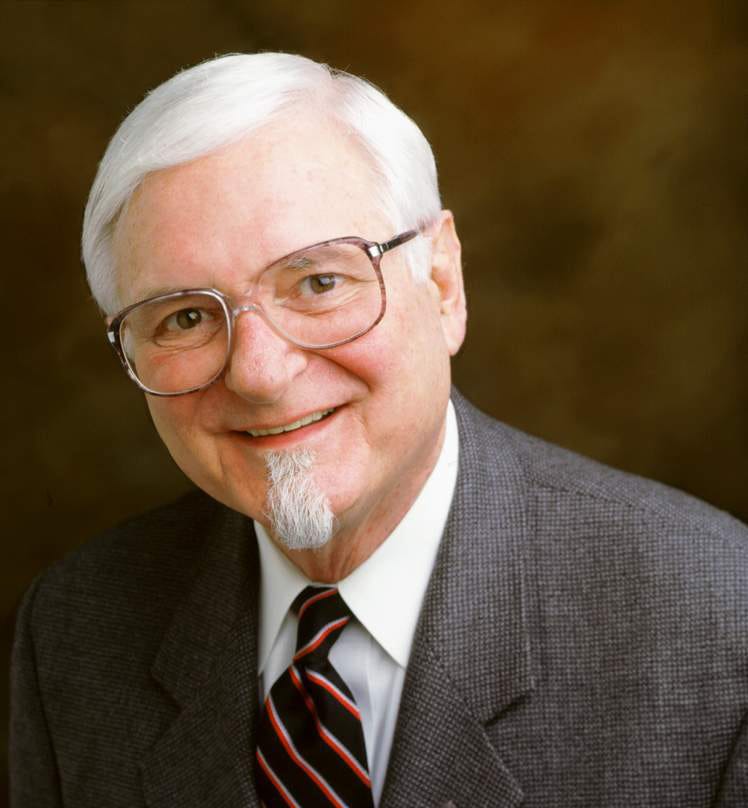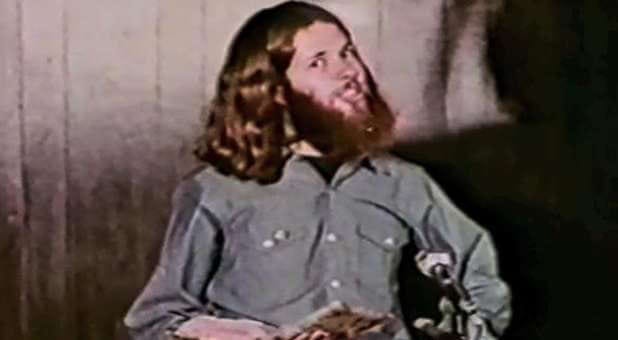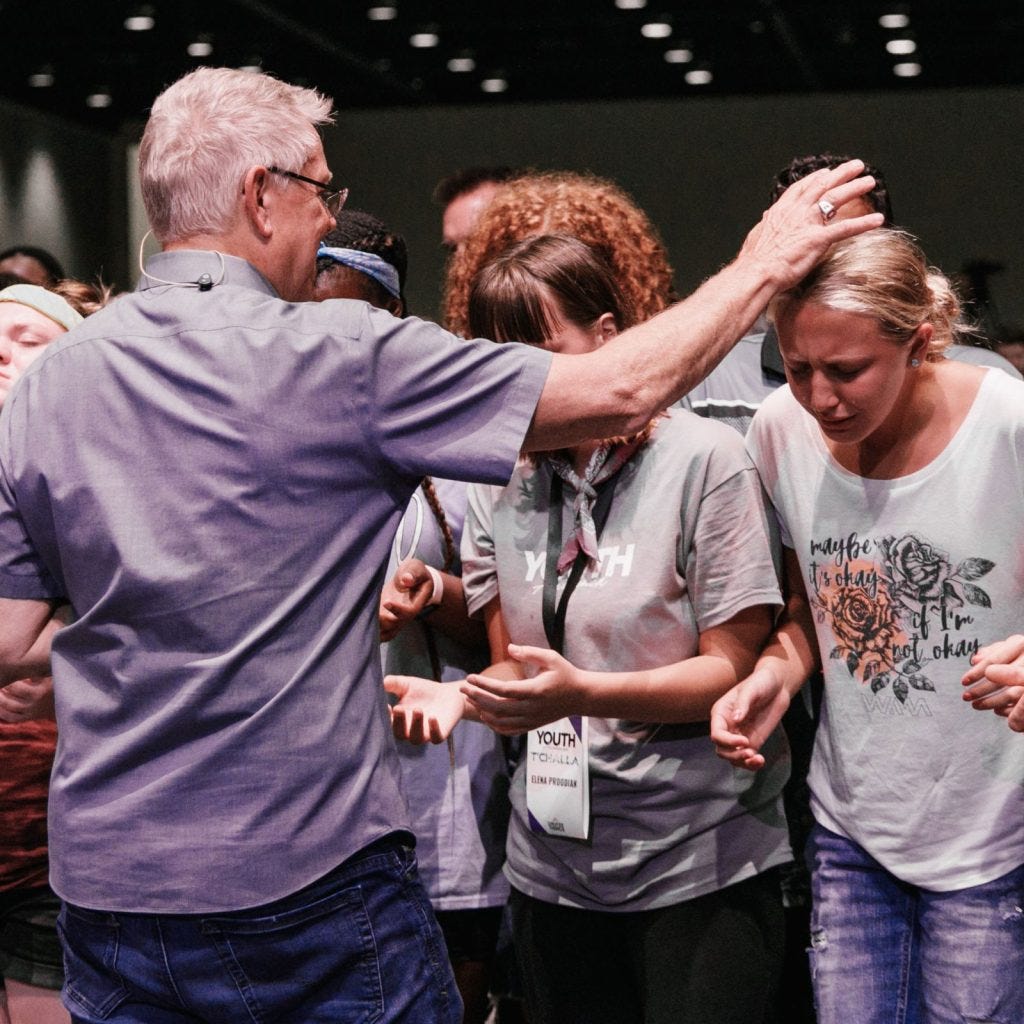The two threads of Revival and the Word of Faith were woven together in a remarkable way by a remarkable group of Christians known as “the Jesus people.” The “Jesus Revolution” or “Jesus People” or “Jesus Freaks” or “Jesus Movement” was born at a time when many young people in the USA were rebelling against established norms and institutions, including traditional churches. It managed to combine Pentecostal and Evangelical approaches. Like the Latter Rain, it was restorationist in tone, seeking to recreate an expression of church life closely resembling the primitive Church described in the Acts of the Apostles, presuming that mainstream Protestant and Catholic communities had defected or moved away from the original essence of Christianity. The Jesus People practiced informal worship, using the same musical instruments found in folk and rock groups; this gave birth to today’s Contemporary Christian Music industry. Another result of its restorationist beliefs was an emphasis on miracles, signs and wonders, and faith healing.
C. Peter Wagner (1930-2016)
Wagner, who would later coin the term “New Apostolic Reformation,” was ordained a minister in the Conservative Congregational Christian Conference. He worked as a missionary in Bolivia, and also studied and taught church growth. While in the early 1970s he had described himself as a “convinced cessationist,” he was intrigued by the dramatic growth in Africa, South America, and China of churches that emphasized miraculous healings. What accounted for their impressive growth? He saw healing as one important contributing factor among many. Others included:
street preaching to draw people in followed by tying them into commitment to church attendance, planting new churches, focus on fields “ripe” for harvesting …, assigning duties to all church members, training pastors functionally using apprenticeship-type training rather than seminary education, and making church fun, social, participatory, and physically active.1
Crucially, Wagner attributed the growth of these churches, not merely to successful strategies and winning approaches, but to the blessing of God. Wagner would shift from an observer of what made churches grow to a theoretician and leader of a new form of Christianity after meeting
John Wimber (1934-1997).
Wimber was one of the Jesus people. In 1962, at age 29, he had a conversion to Christ. His Catholic wife also experienced a rebirth of faith and they had their marriage convalidated in the Catholic Church. At the time, Wimber was working as pianist, singer, and manager of The Paramours, later renamed The Righteous Brothers. He enrolled in Azusa Pacific College (now Azusa Pacific University) and became a Quaker minister. Wimber is today considered the originator of the “signs and wonders” emphasis in today’s NAR. Less attention is generally paid to Wagner’s influence on Wimber and their partnership in the promotion of healing ministry.
In 1975, Wimber, then pastor of Yorba Linda Friends Church, enrolled in the Dmin course at Fuller Seminary, where Wagner was teaching on church growth. Wagner was so impressed with the growth at Wimber’s church that he offered him a job at the Charles E. Fuller Institute for Evangelism and Church Growth (CEFI). Wimber accepted and resigned his pastorate, traveling to promote the Institute and starting a new church at his home. In 1978 he resigned from CEFI to concentrate on his home church, which had begun to place greater emphasis on the power of the Holy Spirit, healing, and supernatural gifts. He felt frustrated when his prayers for healing did not always “work,” especially since he thought that God had spoken to him, confirming that Christians are called to heal in the same way that they are called to evangelize. Everything changed on Mother’s Day, 1980, when Wimber invited a “young hippie” to speak at his church:
Lonnie Frisbee (1949-1993)
Frisbee was in many ways the face of the Jesus Movement, Jesus Revolution, Jesus People, or Jesus Freaks.2 He did not look or dress like a staid Protestant pastor, nor did he have traditional university or seminary training. His ministry began while he was with a group of other hippies in a California canyon, tripping on LSD. He began to preach to them about the Gospel of John and baptized some of them in a waterfall. In 1980, Frisbee was working at Calvary Chapel (pastor Chuck Smith) after spending some time with Bob Mumford in the Shepherding Movement. Wimber later related what happened when Frisbee got up to speak at his church:
He said, “You know the church has been offending the Holy Spirit a long time, and he’s quenched, but he’s getting over it, and we’re going to invite him to come and minister now. Come Holy Spirit.” And Wham-O! The Spirit of God comes, and people start flying! Well, first of all, he says, “Everybody 25 years and under, come forward.” …They’re all coming up there, and there’s hundreds of them up, all crowded around the stage, and he says, “Come, Holy Spirit.” The next thing I know, people are falling and bouncing, and they’re laying on the floor, and they’re talking like turkeys ... And Lonnie is going like a banshee, you know, he’s running through the crowd and raising his hands, and you know. And I’m thinking, he’s pushing people over! He’s knocking them down, but he’s not even touching them. He’s walking by them, and they’re going wham! Wham! You know, they’re falling everywhere, and I’m thinking, “Oh God! Oh God! Oh God! Oh God, get me out of here!” (video)
Wimber was never the same. The event launched the Signs and Wonders movement, which remains an essential part of the NAR to this day. Wimber and Wagner thought that what they called “doin’ the stuff” could be taught, and to that end they announced a new course at Fuller: MC510: Signs, Wonders and Church Growth. And thus the foundations were laid for what would become a key feature of the NAR: “Schools of Supernatural Ministry” (SSMs will be the subject of a future post). From 1982 to 1986, participants in MC510
could learn how to heal ailments and cast out demons in a classroom setting, the format being a teaching session followed by a “clinic” to practise the new skills. The course was wildly popular among its attendees and attracted significant media attention. The healing sessions conducted by Wimber generated excitement, drama, and many claims of renewed passion for Christian experience.3
Obviously, Wagner was no longer a convinced cessationist, but an enthusiastic continuationist. When Fuller cancelled the course after four years, he concluded that its leadership was influenced by a demonic “spirit of religion.”4 Wimber just kept on teaching others “how to do the stuff.” In 1982, Wimber’s church had separated from Calvary Chapel to become part of a new movement, called “Vineyard Christian Fellowship of Anaheim.”
[T]hat year Wimber publicly stated that the church was reporting more than 50 healings per week. The church also grew exponentially, gathering more than 3,000 people weekly only five years after the congregation formed. Much of this growth resulted from what Wimber called “power evangelism”—new believers coming to faith as a result of encountering the power of the living God (reference).
In 1986, Wimber published the book Power Evangelism, co-authored by Kevin Springer, another Vineyard pastor (foreword by Wagner). Together with their 1992 Power Healing, Power Evangelism contains all the course materials from MC510. It has sold over a million copies, and remains influential. Some key teachings of Power Evangelism remain foundational in today’s NAR:
“Power is the ability, the strength, the might to complete a given task. Authority is the right to use the power of God.” (11)
Effective evangelism is proclamation backed up with demonstration: “The explanation of the gospel comes with a demonstration of God’s power through signs and wonders…” (36)
Prophecy in the form of “words of knowledge” plays an important part in evangelism. God gives an evangelist a “word of knowledge” about another, leading him to be healed or commit himself to God.
One of the participants in MC510, Charles H. Kraft (b. 1932), a professor of anthropology and intercultural communication who had been a missionary in Africa, helped Wagner describe and popularize the “power encounter” that characterized Wimber’s ministry. Wagner and Kraft also developed the theology of power evangelism, including a justification for the claim that any Christian has the power to work the same miracles Jesus did:
...Kraft argued the connection between the baptism of Jesus and the filling of everyday Christians with the Holy Spirit. As the source of power, the Holy Spirit began his work when he empowered Jesus at his baptism (Luke 3:21-22); likewise, all believers are empowered when they are filled with the Holy Spirit. Moreover, Christians are empowered to do greater miracles than Jesus (John 14:12). Wagner expounded further: “The Holy Spirit was the source of all Jesus’ power during his earthly ministry. Jesus exercised no power of or by himself. We today can expect to do the same or greater things than Jesus did because we have been given access to the same power source.” ... His explanation for Christians’ ability to do greater things than Jesus was made possible by his kenoticist approach to the two natures of Jesus, which he based on Phil 2:6-7. He asserted that Jesus temporarily differed from the Father and the Holy Spirit in having two natures. He subordinated himself to God by totally suspending all use of his divine attributes. This made him dependent on the Holy Spirit’s working for any power that he demonstrated.5
The Third Wave of the Holy Spirit
Wimber’s ministry, reinforced by the growth of Vineyard congregations, and the backing of academics like Wagner and Kraft, gave birth to what Wagner called the “Third Wave of the Holy Spirit.” In his analysis, the First Wave began at the time of the Azusa Street Revival, and the Second Wave occurred in the 1960s when charismatic ideas and practices spread into Protestant and Catholic communities. The Second Wave was characterized by “Word of Faith” beliefs and its “name it and claim it” practices. What made the Third Wave new was the emphasis on “signs and wonders” or “power evangelism” as opposed to earlier manifestations of the Holy Spirit such as speaking in tongues.
A galvanizing event in Third Wave Pentecostalism took place in Toronto in 1994. Journalists called it “The Toronto Blessing.” This event brought to prominence someone who remains a leading figure in the NAR today:
Randy Clark (b. 1952)
The Toronto Blessing
Randy Clark began ministry as a Baptist pastor, but left that denomination in 1984 after meeting John Wimber, who prophesied that Clark “had an apostolic call on his life and would one day have a translocal ministry of impartation.” Clark was also influenced by the South African preacher Rodney Howard-Browne. After conversations involving Benny Hinn, Claudio Freidzon, and Howard-Browne, John and Carol Arnott invited Clark to speak at their Toronto Airport Vineyard church for four days in January, 1994; four days turned into 42. At first, 200 people turned out to hear Clark. Soon 500-1000 showed up daily to attend a four- to five-hour worship service that ran six days a week. At the one-year anniversary service, 4,000 took part.
What did they experience? Press coverage emphasized outward phenomena, especially the “holy laughter” that was considered the result of overwhelming joy, but journalists noticed other, less jolly manifestations. Robert Hough, writing in Toronto Life magazine (which named the Toronto Blessing the #1 tourist event in Toronto in 1994) recounted what he saw:
The man sitting beside me, Dwayne from California, roared like a wounded lion. The woman beside Dwayne started jerking so badly her hands struck her face. People fell like dominoes, collapsing chairs as they plunged to the carpeting. They howled like wolves, brayed like donkeys and — in the case of a young man standing near the sound board — started clucking like a feral chicken. And the tears! Never have I seen people weep so hysterically, as though every hurt they’d ever encountered had risen to the surface and popped like an overheated tar bubble. …people were screaming, their bodies jerking unnaturally, their faces contorted with tics.6
For John and Carol Arnott, these were all signs of the Holy Spirit coming down from heaven. Many of the phenomena that made Toronto Airport Vineyard church famous, such as laughter, convulsive movements, and people falling over, had happened before. Such behavior even pre-dated the 20th century “revival”, but it was novel for most people in 1994. Rodney Howard-Browne had experienced “holy laughter” in 1979, and spoken about it publicly. John Wimber had seen his congregants falling over and gobbling like turkeys in 1980.
This point is stressed by [Philip] Richter who writes that “the ‘Wimber Wobbles’ predated the ‘Toronto Trots’ by ten years.” Accompanying the phenomena was the talk of revival. The globally disseminated “Equipping the Saints” conferences and the like, organized by Vineyard, more than hinted that “equipping” God’s people meant preparing for revival. This was given further emphasis through Vineyard’s connection with Paul Cain and the other so-called Kansas City Prophets for whom the coming revival was associated with the eschatology of the Last Days.7
This put Wimber in a tough spot.
His position was difficult because the events of the Toronto Blessing bore resemblance to those that he had promoted as the work of the Holy Spirit since 1980, but they seemed more extreme than he could safely defend. Initially he appeared to endorse what was happening in Toronto but eventually, after a messy and contentious process, Toronto Airport Vineyard was asked to leave the Vineyard Association in December, 1995.8
Legacy of the Blessing
Many Christian pastors and leaders went to Toronto to see the experience for themselves. Some kept an open mind, some decided the revival was counterfeit, and others went away with their beliefs and ministries forever transformed. In this final category was a fifth-generation minister from Redding, California: Bill Johnson (1951-) who would soon become the leader of the most influential NAR Church in the USA: Bethel Church.
Conclusion
By now, Faithful Reader, you are wondering what seismic event is about to occur. We have seen how the Latter Rain Revival was condemned by the Assemblies of God, how Fuller cancelled a course in signs and wonders, and how the Vineyard distanced itself from the Toronto Blessing. We have seen Christian pastors, theologians, and just plain folks hungry for some new expression of Christianity that would set the world ablaze for Christ. The time was ripe for some new form of church life to come into being, one that would affirm that all these “new things” were the work of the Holy Spirit, a kind of new wine that could not be contained by the old wineskins of existing denominational structures and strictures. The first three parts of this history have outlined all the components that would come together in the new wineskin. We shall see how they all came together in the fourth and final part of this brief history of the NAR:
CHURCHQUAKE.
Yvie Ruth Baker, From Peter Wagner to Bill Johnson: The History and Epistemology of the “New Apostolic Reformation.” PhD Thesis, University of Otago, 2021, p. 51. My account of Wagner and Wimber’s collaboration is taken from this thesis, an invaluable piece of research which I will cite elsewhere.
Perhaps I should have written “face of Jesus” since, in the movie Jesus Revolution, Frisbee was portrayed by the actor Jonathan Roumie, who also plays Jesus in the tv series The Chosen.
Baker, 60.
C. Peter Wagner, “The Corporate Spirit of Religion,” in Freedom from the Religious Spirit, ed. C. Peter Wagner (Ventura, CA: Regal Books, 2005), 22-23. Cited in Baker, 61. What is meant by “spirit of religion” is explained by the publisher’s blurb: “Composed of archaic traditions and obsolete practices, and masterminded by the enemy of our souls, the spirit of religion seeks to keep individual believers and the corporate church stagnant and unaware of the call of the Holy Spirit for change. We witnessed the spirit of religion when the Pharisees failed to recognize the coming of the Christ. Today, the spirit of religion can be so subtle that we are unaware of its impact, instead being deceived into believing that God is directing us. Only when we recognize the hold that this counterfeit religion has over Christianity can we be freed to experience the transformation of the Holy Spirit in our lives and in the heart of the church. Join C. Peter Wagner and other dynamic Christian leaders as they unveil the dark influence of the spirit of religion.”
Baker, 73-74. The quotations are from Kraft’s book Christianity with Power.
Quoted in James A. Beverly, Holy Laughter and the Toronto Blessing. An Investigative Report. Grand Rapids: Zondervan, 1995, 12.
Stephen Hunt, “The ‘Toronto Blessing’ — A Lesson in Globalized Religion?” in Michael Wilkinson, ed., Pentecostalism in Canada: an introduction. Montreal: McGill-Queen's University Press, 2009, 241.
Baker, 66. Toronto Airport Vineyard was renamed Toronto Airport Christian Fellowship, and is now Catch the Fire.








Holding my breath for part 4, Father…please tell us more.